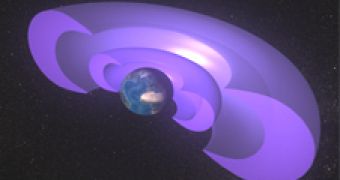On Earth, we depend on the behavior of electrons every day; we can do nothing without the help of electricity. But in space, electrons are no good for us. Powerful electromagnetic pulses can knock a computer out in an instant if not protected, not to mention of radiation poisoning caused by electrons speeding at velocities close to that of light, traveling through the tissues of any living being.
So, why don't electrically charged particles reach the surface of the Earth and kill all living beings? NASA says that the answer may be found in a structure surrounding our planet, packed with highly energetic electrons: the Van Allen Belts, discovered by Dr. James Van Allen with the help of the Explorer-1 spacecraft, in the late 1950s. They consist of two concentric shells surrounding the Earth, and are formed by electrons trapped by Earth's powerful magnetic field.
Most of the time, the Van Allen belts block the highly energetic charged particles hurdling towards the surface of the Earth; however, from time to time, Earth's magnetic field pumps so much energy into electrons that it can determine the formation of a powerful radio emission, ten times bigger than any known radio emission. Such radio emission was known to man ever since the World War I and appears in the radio domain as a whistler, but it has been determined that it is generally determined by lightning discharges.
Professor Cynthia Cattell, from the University of Minnesota, writes that electrons absorb energy from these whistlers and are accelerated to speeds as high as 99 percent of the velocity of light. However, these interactions were previously known to scientists, while the time required to energize a single electron was simply startling. Previously, it was thought that, during these processes, the interactions could span as long as a few hours, while the study led by Cattell suggests that the amount of time necessary to energize electrons is only a tenth of a second.
Data has been provided by the spacecraft STEREO, formed of two identical instruments orbiting the Sun in a special formation, which enables the creation of a 3-D image of the Sun. The Time Domain Sampler, or TDS for short, on-board the spacecraft was intended to measure the flow of electrically-charged particles inside the solar wind. Keith Goetz, on the other hand, the designer of the instruments equipping the two orbiters, had the brilliant idea of testing the TDS before the orbiters drifted far away from Earth.
Thus, on December 12, 2006, the two TDS instruments became operational and executed a fly-by around the Earth, right through the outer Van Allen Belt, at an interval of 84 minutes. The chance made that, right during the period of the fly-by, the Earth's magnetosphere was hit by a substorm, which determined the release of massive amounts of energy in the form of radio emissions.

 14 DAY TRIAL //
14 DAY TRIAL //